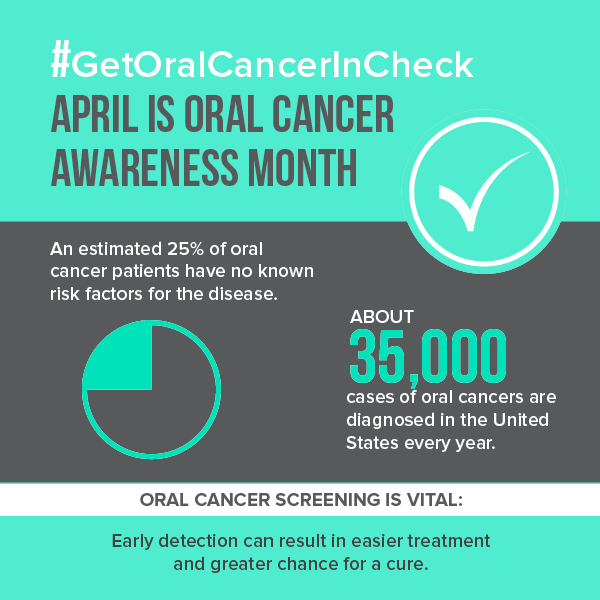
April is Oral Cancer Awareness month. Most people don’t realize how dangerous oral cancer can be. When we usually think of cancer we do not tend to associate it with oral care or oral check-ups.
An estimated 25% of oral cancer patients have no known risk factors for the disease. Early detection can result in easier treatment and the possibility/chance of a cure.

Oral Cancer can appear in your oral cavities which include, lips, cheeks, gums, tongue, bottom, and roof of your mouth and throat. HPV and throat cancer are a few examples of the forms of oral cancer you can contract. It’s important to be aware of the symptoms and signs that can appear. See below, if you have any of these symptoms, let your dentist know if they have not disappeared in two weeks or more.
- Sore or irritation that is not going away
- Red and White patches
- Pain or numbness in lips or mouth
- Difficulty chewing, swallowing
- Difficulty with tongue and jaw movement
- Lumps, thickening of small eroded areas
- Change in the way your teeth fit together when you close your mouth
- Sore throat or feeling of something caught in your throat
- Change in voice
- Earaches
In order to prevent oral cancer, you must simply watch out for the risks and pay attention to the signs and symptoms you may be experiencing. If you drink heavily, smoke, or have a poor diet, these can cause you to be more at risk. Changing these habits will allow you to decrease your chances of oral cancer.
HPV can also put you at risk, depending on the strain you have. Make sure to get the HPV vaccine as this may prevent any kind of infection, again decreasing your chances of infection. HPV is a sexually transmitted disease that can be spread through direct sexual contact to genital areas as well as oral (mouth and throat). Oral HPV can be transmitted through oral sex and most people can be cured while others can have infections that persist. HPV can infect the oral area and cause cancer of the “oropharynx” which is the back of the throat, including tongue and tonsils. HPV is thought to cause 70% of oropharyngeal cancers in the United States. As stated previously, alcohol and smoking can cause you to be more at risk but in order to prevent HPV, another way to decrease your chance is using condoms and dental dams which can lower the chance that HPV is passed on.
In order to ensure your safety, talk to your dentist today and make sure if you have any irregularities or signs that persist beyond a two week period that you get it checked out to ensure earlier treatment!
Protect yourself and your oral health today! Visit your dentist for an oral screening and discuss HPV vaccinations with your family doctor.